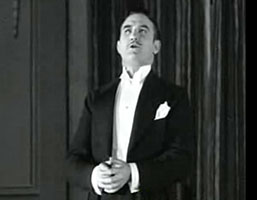 The title card for the short musical film starring Tom Burke (1890-1969) "the Lancashire Caruso" reads in its entirety And now Pathetone Weekly presents teh World famous Operatic Tenor, Thomas Burke (1933). The title card for the short musical film starring Tom Burke (1890-1969) "the Lancashire Caruso" reads in its entirety And now Pathetone Weekly presents teh World famous Operatic Tenor, Thomas Burke (1933).
This is followed by a text card that informs us Thomas is "Singing to disabled ex-service men at a Concert at Queen Mary's Hospital, Roehampton (Organized by the Stock Exchange War Wounded Entertainment Fund.)"
The musical short is a little over five minutes. We're shown the audience of war wounded, some wheeled in in beds. We hear the piping tenor voice of Thomas Burke with a rather echoey sound recording. The scene then cuts to the stage, where Burke stands beside a seated piano accompanyist. He's singing "I Dream of the Day I Met You" by Tosti.
It's a sweet old timey number from a world that never new a tiddle or a jot's worth of ragtime. Easy to imagine this being sun in a Victorian parlor by any well-trained but unimaginative tenor. There's naytheless a plaintive tone suited to the cut-aways to injuired men.
His second number is "For You Alone" by composers Henrty Geehi & P. J. O'Reilly. It has a definite operatic tone with a certain kitsch appeal. In one jump-cut we see a section of nurses listening, shown from an overhead angle as though they're in a pit.
I can't help but suppose a huge percentage of that audience of soldiers was bored. Hopefully some chorus girls came running out as soon as Burke was finished.
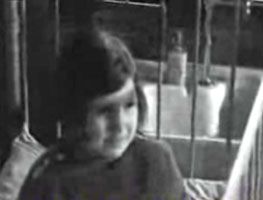 "And now, over to one of the Wards of the Middlesex Hospital, London, to hear Tom Burke, the celebrated Operatic Tenor, entertaining patience. At the piano, Rene Cook." So reads teh opening text card for Tom Burke, Singing at Middlesex Hospital (1933).
"And now, over to one of the Wards of the Middlesex Hospital, London, to hear Tom Burke, the celebrated Operatic Tenor, entertaining patience. At the piano, Rene Cook." So reads teh opening text card for Tom Burke, Singing at Middlesex Hospital (1933).
Rene Cook, well known in her day, sits at her piano. Burke stands with an elbow on the top of the piano singing "Maire My Girl (Over the Dim Blue Hills)," which was once a standard of all Irish Tenors, popular also in the Victrola days. The lyric by Irish poet & balladeer John Keegan Casey (who died young, on St. Patrick's Day in 1870) may jog the memory of a few:
"Over the dim blue hills strays a wild river/ Over the dim blue hills rests my heart ever/ Dearer & brighter than jewels & pearl/ Dwells she in beauty there, Maire my girl."
We're shown an audience of appreciative nurses & patients, including small children, & rows of bedridden too ill to look up. At two & three-quarters minute the son is soon over, with nurses shown clapping & squirming in their seats.
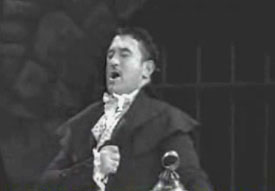 Another "issue" of Pathetone Weekly shows a fragment of Tom Burke's performance in Tosca.
Another "issue" of Pathetone Weekly shows a fragment of Tom Burke's performance in Tosca.
The first text card reads, "One of Puccini's greatest operas was 'Tosca,' the immortal areas from which have moved the hearts of the world," followed by a second text card, "Today, we present the famous scene from Act III, where, in the Castle of St. Angelo, Rome -- Mario Cavaradossi is a prisoner. A jailer enters with Mario's death warrent. He is to die in an hour."
A plot worthy of any cheesy Victorain melodrama aimed at the unbathed masses, it's surprising this is regarded highbrow. The third text card reads, "Mario signs the register then sits down & reflects. He asks his jailer's permission to write a letter to his lover & offers his signet ring as a bride, which eventuyally the jailor accepts."
And then a forth text card: "Then, Mario writes, but becoming engrossed in memories of past happy moments -- he rises & sings of his deep despair."
Only with a fith text card are we given the title, Mario (1933) starring "Tom Burke, the world famous opera tenor." For a film slightly more than five minutes long, 45 seconds of introductory text before anything begins is a long time.
We then see the prison sceen with a well dressed prisoner singing to the guard, significantly less well dressed. The letterwriting scene begins as already described to us, payment of the ring, emotional distractions, & then the main body of the song, in Italian.
It's quite wonderfully played really, though I liked the anonymous rawboned guard more than the well fed Mario.
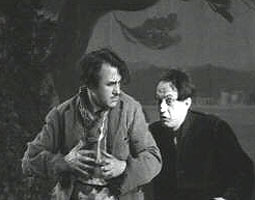 The opening text card says: "The tragedy of Canio, chief of a trokupe of Strolling Players, has resounded throughout the world in the famous Opera -- Pagliacci (The Clown)."
The opening text card says: "The tragedy of Canio, chief of a trokupe of Strolling Players, has resounded throughout the world in the famous Opera -- Pagliacci (The Clown)."
A second card follows & as we read it, we can already hear Tom Burke singing. The card tells us:
"Canio discovers his wife (Nedda) has a lover, but she refuses to divulge his name, & Canio is about to attack her, when his friend Peppe (the Harlequin) prevents him, imploring him to go on with the show -- the people are coming."
The third card reads: "And Tonio, the hunchback, who seeks revenge on Nedda, assures him taht the lover will return."
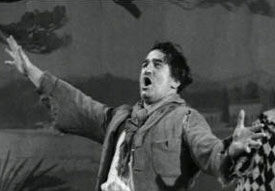 The fourth card is the title card, which reads, "Pathetone presents the world famous Operatie Tenor Tom Burke as Canio (the Clown) in On With the Motley." The fourth card is the title card, which reads, "Pathetone presents the world famous Operatie Tenor Tom Burke as Canio (the Clown) in On With the Motley."
We then cut to an opera stage with Peppe in a checked outfit, Canio in torment, & stooped Tonio outside a large theater tent with a sign "Teatro" over the flaps.
Both Tonio & Canio are singing, in English rather than Italian. It's overacted in the operatic manner as a day of abject doom.
As captured Thomas Burke as Canio in 'On With the Motley' (1934), it's not musically very interesting, but everyone emotes nicely. We don't see Canio in his Pierotte motley, for it's a scene before the more famous scene. This ends with over-the-top weeping & his entry into the tent to prepare ironically for comedy.
copyright © by Paghat the Ratgirl
|
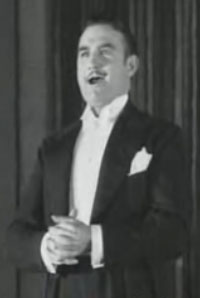




 The fourth card is the title card, which reads, "Pathetone presents the world famous Operatie Tenor Tom Burke as Canio (the Clown) in On With the Motley."
The fourth card is the title card, which reads, "Pathetone presents the world famous Operatie Tenor Tom Burke as Canio (the Clown) in On With the Motley."